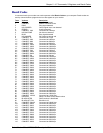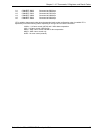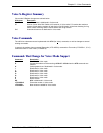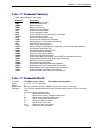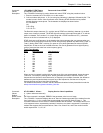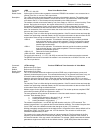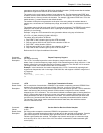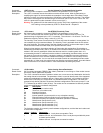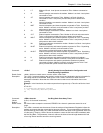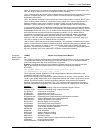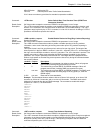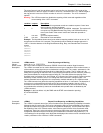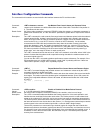
Chapter 6 – Voice Commands
SocketModem Global MT5634SMI Developer’s Guide 50
generates a dual tone at 3000 and 3300 Hz for the default duration. [,3300] means that the modem
generates a single tone at 3300 Hz for the default duration.
The quantity in the curly braces consists of a two-element list. The first element is the DTMF tone
character, and the second element is the tone duration in 0.01 seconds. The DTMF tone characters
are listed above. A list may contain null elements. For example, {@} means DTMF tone "2" for the
default duration. {} means silence for the default duration.
The modem will stop the tone generation at the point in the string where the modem detects a
parsing error, encounters an invalid frequency range, encounters a <CR>, or encounters a semi-
colon.
The modem returns the OK result code if the PC accepts the command. The ERROR result code is
displayed if the modem encountered an error in parsing the subparameter, or if the selected
frequency is out of range.
Example: Using the +VTS command for tone generation without using any null elements:
AT=VTS=1,2,[1000,1300,50],{*6},{800,1300,50},9
The above string will perform as follows:
1. Play DTMF 1 with a duration given by the +VTD command.
2. Play DTMF 2 with a duration given by the +VTD command.
3. Play tone pair at 1000 Hz and 1300 Hz with a duration of 500 ms.
4. Play DTMF * with a duration of 60 ms.
5. Play tone pair at 800 Hz and 1300 Hz with a duration of 500 ms.
6. Play DTMF 9 with a duration given by the +VTD command.
Refer to the IS-101 Spec for additional information.
Command: +VTS=? Report Frequency Support
Result Codes: OK follows the string
Description: The +VTS=? command reports the current frequency range in the form <freq1>,<freq2>,<dur> ,
where <freq1> is the first frequency range,<freq2> is the second frequency range, and<dur> is the
duration range for the square brackets and curly braces constructs. The units are in 0.01 seconds.
The range of valid <dur> values is that of the +VTD command.
Example: In the lines below, the modem responds to the +VTS=? command by reporting that it
supports two frequencies, both in the range of 200-3300 Hz, and supports a duration range from 0
to 5 seconds.
AT+VTS=?
(200-3300), (200-3300), (0-500)
OK
Command: +VTX Start Voice Transmission Process
Result Codes: OK on completion of transmission; CONNECT if the modem accepts the command; ERROR if the
modem is not connected to at least one off-hook Telco line, or one non-Telco device.
Description: The +VTX command causes the modem to start the voice transmission process. The PC sends the
data in the format of the previously entered +VSM command, using the flow control method
selected by the +FLO command. The voice data is buffered to withstand gaps of missing data from
the PC. If the modem does not have any current voice data, the modem sends silence over to the
analog destination until the PC provides more voice data. The modem returns the OK result code
and returns to Command mode after the modem has completely transmitted its buffer contents.
The Inactivity Timer can be used to terminate the transmit data state, after which the modem
returns to Command mode.
Command: +VGR=<gain> Set the Gain for Received Voice Samples
Values: 0–255
Result Codes: OK if the modem accepts the command; ERROR if the parameter is out of range.
Description: The +VGR= command causes the modem to set the gain for the received voice samples. Receive
gain values larger than 128 indicate a larger gain than nominal, and values smaller than 128
indicate a gain smaller than nominal. The modem may limit the receive gain to a narrower range,
such as from 120 to 136, or from 120 to 128. The value 0 is reserved for modem automatic gain
control (AGC).



